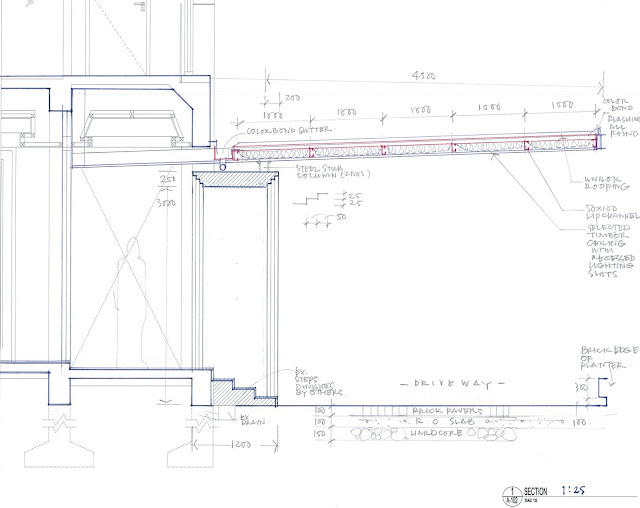Monday, May 29, 2017
Saturday, May 20, 2017
Work sketches from last week 14-21 May
Architectural Journal entry No. 1 this year - as a record of things that happened at work this week. The first was a 3 hour exercise to see how we can fit 150 people in a new open plan - the client rang up at 1030 'are you in the office, I'll swing by at 11 to talk to you about a new project'. He dropped by, we chatted about raised access flooring, toilet provisions, time frame and when he wanted the first round of layout plans. 'This afternoon, 230 would be perfect'
For many of our houses, we designed the landscape as well - trying to fit the poetic with the utilitarian; laundry can dry out of sight behind a garden wall, the edge of a pool doubles as a bench and base for water spout. I find these sketches very useful as conversation starters with the client.
The end of the living space is enlarged with the introduction of a window seat; to collect people for conversation, without outside views to interrupt the chit chat.
View of the conversation area from the atrium
For many of our houses, we designed the landscape as well - trying to fit the poetic with the utilitarian; laundry can dry out of sight behind a garden wall, the edge of a pool doubles as a bench and base for water spout. I find these sketches very useful as conversation starters with the client.
The end of the living space is enlarged with the introduction of a window seat; to collect people for conversation, without outside views to interrupt the chit chat.
View of the conversation area from the atrium
Labels:
architect's sketches,
hand drawn,
MinWee Architect
Monday, May 15, 2017
Building in Sarawak
 Architecture students sometimes ask to interview me for their assignment about local architects and their design thinking and influences. This is a recent questionnaire (I have not corrected the student's grammar but I will ask to proofread and review his final assignment)
Architecture students sometimes ask to interview me for their assignment about local architects and their design thinking and influences. This is a recent questionnaire (I have not corrected the student's grammar but I will ask to proofread and review his final assignment)• How has the architecture character in East Malaysia / Kuching changed in the last 15 years?
One simply has to look to see that we are getting our share of buildings which can be found anywhere else in the region. They do not contribute significantly to the city's skyline, nor to the user's experience of it space.
Despite this, there are some smaller projects which stand out as good examples of local architecture - relating well to its context and culture, innovative use of local material and skills, with appropriate response to the tropics.And like most good things, they take a bit more work to find, but they are there.
I have a strong bond with many of the buildings of my childhood. Many are located in Kuching's Chinatown; the old Courthouse, St. Joseph's Cathedral and open air market, the central padang and the waterfront.
• Please name 3 buildings that you fond the most, does each of them reflects your idealogy?
• If you have the power to design and built a building/place that could create something good for the society, what would it be, and why?
Any building that the public comes into contact with is worth doing, and doing well.
 • Which building in Kuching do you think is worth preserving? Why do you say that?
• Which building in Kuching do you think is worth preserving? Why do you say that? For any building to be preserved, and deserve the investment to do that - it must have a present day function, it must contribute to its upkeep.
• What is the difference of architectural evolution/progress in between West and East Malaysia?
It's the same, just at a slower pace. We are making the mistake of trying to be like "them" and firing who we really are.
• How do you want to see Kuching city develop?
There needs to be an overall masterplan for Sarawak; one that includes the development of public transport, infra structure, the environment and public amenities such as schools, libraries and hospitals.
• In architectural context, what is Kuching City greatest need now?
More public spaces where people can meet and spend time with their family. Roads with bicycle lanes, a better bus system. It's not architecture that will solve a city's problems, it's planning and education that would help the most.
• In your opinion, what do you think of current Malaysia architecture status?
We are trying too hard to be like everyone else, that we have forgotten who we are.

• What is your word of advice to all the young architects in Malaysia?
To continue learning; through travel, books, work experience and by making mistakes. To be brave and take risks; you'll never know your limits otherwise. To listen; that's the best design tool.
Friday, May 5, 2017
Laying the ground work
These are supplementary construction drawings for a renovation to a small boutique hotel. I often find it easier to add my intended details by hand to the CAD drafted 'frame-work' - I feel that it gives me better exploration and control, and it is also a way to double check the design.
For small practices, this is perhaps an efficient way to releasing construction drawings to the contractor - photocopied in A3, emailed as PDF files, with peace of mind that I have looked through and provided input.
Subscribe to:
Comments (Atom)



















